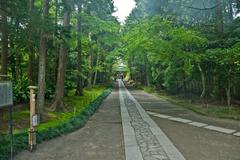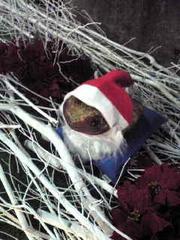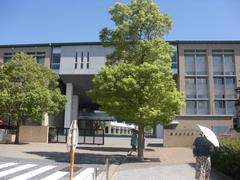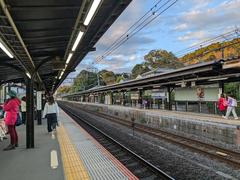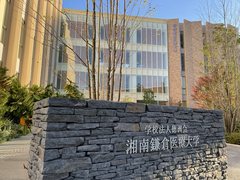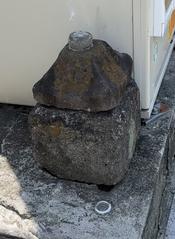
Wakamiya Ōji: Visiting Hours, Tickets, and Comprehensive Guide to Kamakura’s Historic Avenue
Updated: 04/07/2025
Introduction
Wakamiya Ōji, Kamakura’s grand ceremonial avenue, is a living testament to Japan’s samurai era, urban planning, and spiritual heritage. Stretching 1.8 kilometers from Yuigahama Beach to the revered Tsurugaoka Hachimangū Shrine, this iconic thoroughfare invites visitors to journey through centuries of history, culture, and seasonal beauty. From the stately torii gates and the cherry blossom-lined Dankazura walkway to bustling shopping streets and time-honored festivals, Wakamiya Ōji is a must-visit for anyone exploring Kamakura’s historical sites. This detailed guide provides up-to-date information on visiting hours, ticketing, accessibility, travel tips, and surrounding attractions to ensure an enriching and seamless experience (Samurai Archives, Japan Guide, Nippon.com).
Table of Contents
- Historical Overview
- Visiting Information
- What to See and Do
- Travel Tips and Etiquette
- FAQs
- References and Further Reading
- Conclusion
Historical Overview
Origins and Urban Design
Wakamiya Ōji was constructed in the late 12th century under Minamoto no Yoritomo, the founder of the Kamakura shogunate (Samurai Archives). Serving as the city’s primary axis, the avenue linked Sagami Bay to Tsurugaoka Hachimangū Shrine—symbolically connecting the sea (purification) to the sacred (protection). Its broad, straight design distinguished Kamakura from older, winding Japanese cities and was integral to processions, festivals, and the visibility of governmental power (Nippon.com).
Wakamiya Ōji’s three imposing torii gates divide the avenue into sections, each representing a threshold between the secular and sacred. The city’s urban layout, influenced by Chinese geomancy, intentionally aligned the avenue north-south, taking advantage of Kamakura’s natural defenses and spiritual symbolism (Japan Experience).
The Dankazura: Elevated Walkway
A defining feature is the Dankazura—an elevated, stone-paved walkway that runs for about 500 meters from the second to the third torii gate (Japan Guide). Originally built to prevent flooding and to provide a dignified approach for nobles and clergy, it is now lined with over 170 cherry trees. This creates a spectacular “tunnel” of blossoms during late March to early April, making it one of Kamakura’s premier hanami (cherry blossom viewing) spots (Torip Japan). The Dankazura narrows as it approaches the shrine, enhancing the sense of distance and grandeur.
Cultural and Spiritual Significance
Wakamiya Ōji functioned as the ceremonial approach to Tsurugaoka Hachimangū, Kamakura’s most significant Shinto shrine dedicated to Hachiman, the patron deity of the samurai (Japan Guide). The avenue was historically reserved for processions and religious rituals, reinforcing the shogunate’s authority and the city’s spiritual centrality. Today, it remains the focus of major festivals—including New Year’s hatsumōde and the autumn Reitaisai—when thousands throng the avenue in celebration.
Visiting Information
Visiting Hours
- Wakamiya Ōji: Open 24 hours, year-round, as a public thoroughfare.
- Tsurugaoka Hachimangū Shrine:
- March–October: 5:30 AM – 8:30 PM
- November–February: 6:30 AM – 7:00 PM
(Hours may vary; check the shrine’s official website for updates.)
Tickets and Admission
- Wakamiya Ōji: No admission fee; the avenue is public.
- Tsurugaoka Hachimangū Shrine: Free general entry; small fees (typically ¥300–¥500) may apply for special exhibitions or museum facilities within the shrine.
Accessibility
- Wheelchair/Stroller Access: Wakamiya Ōji and Dankazura are largely flat and paved, suitable for wheelchairs and strollers. Some steps exist near the shrine, but alternative accessible routes are available.
- Restrooms: Public facilities are located at Kamakura Station, Tsurugaoka Hachimangū, and along the avenue.
Getting There
- By Train:
- JR Yokosuka Line: Direct from Tokyo Station to Kamakura Station (about 1 hour, ¥950).
- JR Shonan Shinjuku Line: Direct from Shinjuku Station to Kamakura Station.
- By Local Transit:
- Odakyu Enoshima Kamakura Free Pass: Budget option, includes unlimited Enoden train travel (Japan Guide).
- From Station: 3–10 minute walk from Kamakura Station (East Exit) to the avenue’s southern beginning.
What to See and Do
Landmarks and Highlights
- Three Torii Gates: Mark transitions along the avenue (visit.trip-kamakura.com).
- Ichi-no-Torii: Near Yuigahama Beach—symbolic entrance.
- Ni-no-Torii: At the start of Dankazura, intersection with Komachi-dori.
- San-no-Torii: Entrance to Tsurugaoka Hachimangū’s sacred precincts.
- Dankazura: Elevated, cherry blossom-lined walkway; best visited in late March–early April (Torip Japan).
- Tsurugaoka Hachimangū Shrine: Kamakura’s spiritual heart; features a grand staircase, lotus ponds, and a museum (Japan Experience).
- Komachi-dori: Parallel shopping street with traditional crafts and local delicacies (roughguides.com).
- Yuigahama Beach: Relax or stroll by the sea, accessible from the avenue’s southern end.
Seasonal Events and Festivals
- Cherry Blossom Festival: Late March–early April; the dankazura transforms into a blossom tunnel (Torip Japan).
- New Year (Hatsumōde): Massive crowds for the first shrine visit.
- Reitaisai (September): Shrine’s grand festival with processions and horseback archery (traveler-japan.com).
Food, Shopping, and Facilities
- Dining: Sample fresh seafood, soba, and local sweets along Wakamiya Ōji and Komachi-dori. Popular stops: Kamakura Joan (handmade soba), Kamakura Woodberries+ (frozen yogurt), arbre noir YAKUMI (Kamakura Yaki) (Skyticket).
- Shopping: Souvenirs include Kamakura-bori (lacquerware) and Hato Sablé (biscuits) (Tabiulala).
- Facilities: Tourist Information Center at Kamakura Station provides maps and multilingual support (Kamakura City Tourist Association).
Travel Tips and Etiquette
- Best Time to Visit: Cherry blossom season (late March–early April) and autumn foliage are most scenic. Arrive early or on weekdays for fewer crowds.
- Comfortable Shoes: Expect extensive walking on stone and gravel.
- Cash: Many small shops only accept cash; ATMs are available near the station.
- Respect: Refrain from eating while walking along Dankazura, keep noise levels down, and dispose of litter properly.
- Photography: Allowed, but be considerate during festivals and at religious sites.
FAQs
Q: What are Wakamiya Ōji’s visiting hours?
A: The avenue is open 24/7. Tsurugaoka Hachimangū Shrine is open daily (typically 5:30 AM–8:30 PM; check for seasonal changes).
Q: Is there an entrance fee?
A: No fee for Wakamiya Ōji or general shrine entry. Special exhibitions may incur a small charge.
Q: Is Wakamiya Ōji wheelchair accessible?
A: Yes, the main avenue and Dankazura are generally accessible, though some uneven surfaces exist.
Q: How do I get to Wakamiya Ōji from Tokyo?
A: Take the JR Yokosuka Line or Shonan Shinjuku Line to Kamakura Station, then a short walk from the East Exit.
Q: Are guided tours available?
A: Yes, walking and bicycle tours are offered; booking ahead is advised.
References and Further Reading
- Samurai Archives
- Japan Guide
- Nippon.com
- Japan Experience
- Visit Trip Kamakura
- Torip Japan
- Kamakura Guide
- Tabiulala
- Skyticket
- Kamakura City Tourist Association
Conclusion
Wakamiya Ōji stands as Kamakura’s ceremonial and cultural heart, seamlessly weaving together the city’s samurai legacy, spiritual traditions, and vibrant modern life. With free, 24-hour access, wheelchair-friendly paths, and proximity to must-see attractions, it is ideal for visitors of all backgrounds. Plan your visit around cherry blossom season or autumn foliage, take advantage of early or weekday hours, and enjoy the culinary and cultural delights of Komachi-dori. For current updates, event schedules, and expert tips, download the Audiala app, consult local tourist information, and explore our other Kamakura guides. Experience the unique blend of history and beauty that makes Wakamiya Ōji an essential part of any Kamakura itinerary.










